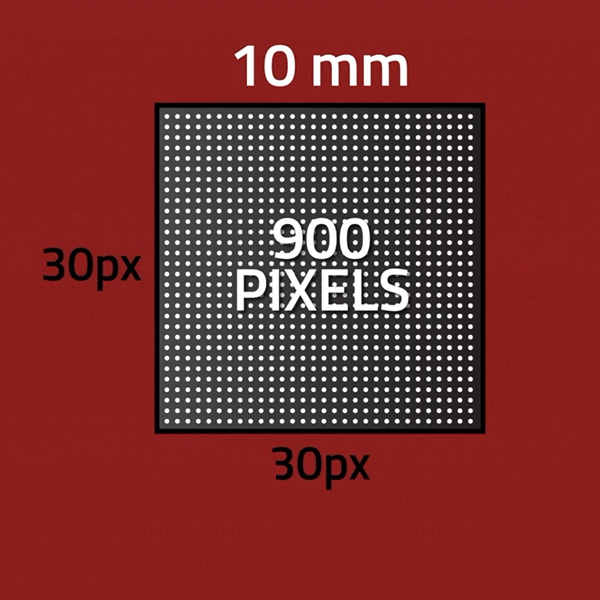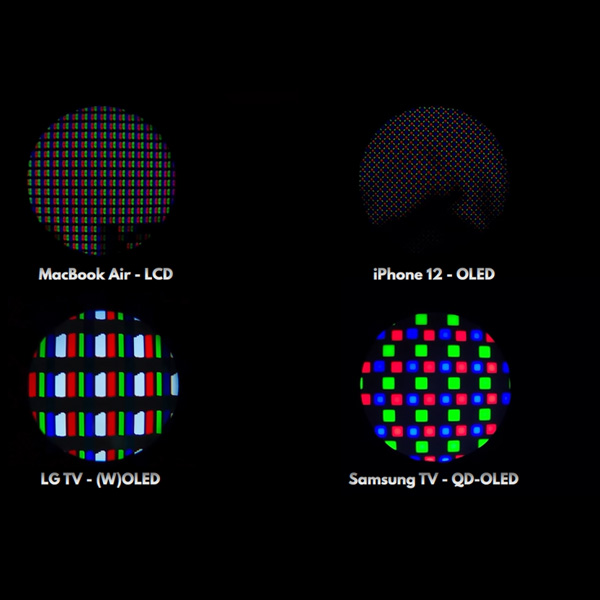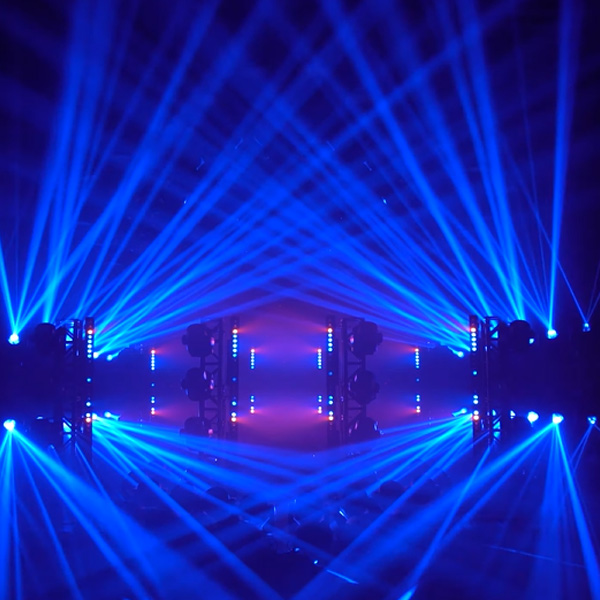The display effect of LED display screen is the result of a combination of multiple technical factors. Below, we will delve into the impact of key factors such as resolution, pixel density, brightness, contrast, grayscale, color, system digital-to-analog conversion bits, system video processing chip, memory and transmission system on the display effect one by one.
Resolution and Pixel Density

Resolution is the core indicator of LED display clarity, which directly determines the number of pixels that can be displayed on the screen.
High resolution means more pixels, which can present more delicate and clear image details. The high-resolution display can bring a more realistic visual experience when playing high-definition videos or pictures.
Pixel density refers to the number of pixels per unit area. High pixel density means that the pixels are denser under the same screen size, thereby improving image detail and viewing comfort. Especially when viewed at close range, a high-pixel density display can reduce graininess and make images smoother and more natural.
Brightness and Contrast
Brightness is a key factor for LED displays to maintain clear visibility under different ambient lights. The high-brightness display can maintain sufficient brightness in outdoor strong light environments to ensure that image content is clearly visible. At the same time, the adjustable brightness function is also an important feature of the display. It can automatically adjust the brightness according to changes in ambient light to maintain the best viewing effect.

Contrast determines how much difference there is between the brightest and darkest parts of the display. High contrast can make images more vivid, three-dimensional and fuller in color. When displaying dark or dark content, high contrast can reduce color distortion and maintain the layering and detail of the image.
Grayscale and Color
Grayscale is the basis for LED display screens to express color levels. It determines the number of brightness levels the screen can display. The higher the gray level, the smoother the brightness transition the screen can present and the richer the color performance. This helps bring out more detail and depth in images and videos.
Color performance is another important aspect of LED displays. A high-quality display can present more realistic and vivid color effects. This involves many aspects such as color gamut coverage, color accuracy, and color saturation. Wide color gamut coverage means the display can reproduce more colors, while high color accuracy ensures that displayed colors are consistent with the original content.
System digital-to-analog conversion digits
The number of digital-to-analog conversion bits in the system determines the accuracy of the display screen in processing image data. The higher the number of bits, the more accurate the image data the display can process, and the transition of color and brightness will be smoother, reducing the loss of image information. This helps improve the overall display effect, making images more detailed and realistic.
System video processing chip
The system video processing chip is one of the core components of the LED display. It is responsible for processing video signals, optimizing image quality, and achieving various display effects. The high-performance video processing chip can bring smoother and more natural video playback effects and reduce image distortion and delay. At the same time, some advanced video processing chips also support a variety of image processing algorithms and special effects, which can further improve the clarity and layering of images.
Memory
Memory plays an important role in storing image data, video signals and control information in LED displays. Sufficient storage capacity ensures that the display can handle large amounts of image and video data to meet the needs of various application scenarios. At the same time, high-performance memory can provide fast data reading and writing speeds, ensuring the response speed and stability of the display.
Transmission system
The transmission system is responsible for transmitting video signals, control signals, etc. from the signal source to the LED display. A stable and efficient transmission system can ensure the real-time and integrity of signals and avoid display abnormalities or delays caused by signal transmission problems. When selecting a transmission system, factors such as its bandwidth, transmission distance, and stability need to be considered to ensure that it can meet actual application needs.
To sum up, these technical factors jointly affect the display effect of LED display. In practical applications, we need to comprehensively consider these factors according to specific needs and application scenarios, and select suitable LED display products and technical solutions. At the same time, with the continuous advancement of technology and the continuous development of the market, the display effects and technical performance of LED displays will continue to be improved and improved, bringing users a more high-quality and efficient visual experience.

LED screen display effect factors FAQs
What impact does the resolution of the LED screen have on the display effect?
The resolution of the LED screen determines the number of pixels on the screen. The higher the resolution and the more pixels, the richer the image details that can be displayed and the higher the image quality. Therefore, when choosing an LED screen, you need to determine the appropriate resolution based on the actual usage scenario and needs.
What impact does the system digital-to-analog conversion number have on the LED screen display effect?
The number of digital-to-analog conversion bits in the system determines the accuracy of the display screen in processing image data. The higher the number of bits, the more accurate the image data the display can process, and the transition of color and brightness will be smoother, reducing the loss of image information. This helps improve the overall display effect, making images more detailed and realistic.
Which is more important, brightness or contrast of LED screen?
Brightness and contrast are both important factors that affect the display effect of LED screens. Brightness determines the visibility of the screen in different environments, while contrast affects the clarity of the image and the degree of color reproduction. Therefore, both are important and need to be weighed based on actual needs when choosing.
What impact does pixel density have on the display effect of LED screens?
Pixel density refers to the number of pixels per unit area. The higher the pixel density, the more delicate the display effect and the closer the viewing distance. In indoor applications, a higher pixel density can usually be selected; in outdoor large-screen applications, factors such as viewing distance and cost need to be considered to determine the appropriate pixel density.
What impact does the LED screen drive circuit design have on the display effect?
The design of the drive circuit has an important impact on the display effect of the LED screen. The driver circuit is responsible for providing stable current and voltage to the LED to ensure its normal operation. If the drive circuit design is unreasonable, it may cause problems such as uneven LED brightness and color distortion, thus affecting the display effect.
What impact does heat dissipation design have on the display effect of LED screens?
Thermal dissipation design is crucial to the display effect of LED screens. LEDs generate heat when working. If the heat dissipation is poor, the temperature of the LED will rise, which will affect its luminous efficiency and stability, and may even shorten the service life of the LED. Therefore, good heat dissipation design is one of the important factors to ensure the stable display effect of LED screen.
What impact does color reproduction ability have on the display effect of LED screens?
The color reproduction capability determines the LED screen’s ability to accurately restore the color information in the original image or video. If the color reproduction capability is insufficient, it may cause color distortion or color cast, thus affecting the viewing experience. Therefore, when choosing an LED screen, you need to pay attention to whether its color reproduction ability meets actual needs.

